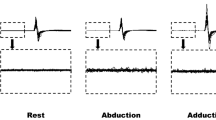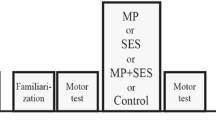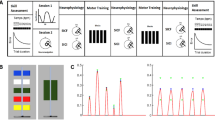Abstract
Task-dependant changes in corticomotor excitability have been described mainly in the context of grasp-oriented actions, neglecting the sensory aspects of hand function. Here, we contrasted task-dependant facilitation in small hand muscles [i.e., first dorsal interosseous (FDI) and abductor digiti minimi (ADM)] in the context of finger movements involving either discrimination or non discrimination (ND) of tactile features. Healthy young individuals (n = 16) were trained to produce rhythmic to and fro movements at the sound of metronome ticks (0.8 Hz frequency, 5 s total duration) with either the index or the little finger of the right hand. In the tactile discrimination (TD) condition, participants were asked to attend to the location of two different 2-D tactile shapes disposed on the explored surface, whereas in the ND condition, the finger was moved over a blank surface. In both conditions, a transcranial magnetic stimulation (TMS) pulse was delivered at a specific time point in the course of the finger movement. Corticomotor excitability was assessed by monitoring changes in the amplitude and latency of motor evoked potentials (MEPs) in the FDI and ADM. Changes in the duration of the silent period were also assessed. The analysis revealed a significant large effect of task conditions (P < 0.001) on MEP amplitude, owing to the increase in MEP size observed during the TD, as compared to the ND condition. No interaction between “Task” and “Muscle” was detected, however, indicating that MEPs in the two muscles were equally affected by the task conditions. No significant changes were detected for variations in MEP latency or in the SP duration. An additional control experiment performed in a subset of the participants (n = 9) showed that MEP facilitation was substantially reduced when attention to sensations arising from finger contact with the shapes was diverted away by completion of a concurrent cognitive task (counting backward by three). These findings provide further insights into the factors influencing task-dependant changes in corticomotor excitability during hand actions. Our results highlight the importance of behavioral context and attention, in particular, in leading to further enhancement in corticomotor excitability when the finger is actively engaged in TD.




Similar content being viewed by others
References
Abbruzzese G, Trompetto C (2002) Clinical and research methods for evaluating cortical excitability. J Clin Neurophysiol 19:307–321
Bodegård A, Geyer S, Grefkes C, Zilles K, Roland PE (2001) Hierarchical processing of tactile shape in the human brain. Neuron 31:317–328
Bonnard M, Gallea C, De Graaf JB, Pailhous J (2007) Corticospinal control of the thumb-index grip depends on precision of force control: a transcranial magnetic stimulation and functional magnetic resonance imagery study in humans. Eur J Neurosci 25:872–880
Buys EJ, Lemon RN, Mantel GW, Muir RB (1986) Selective facilitation of different hand muscles by single corticospinal neurones in the conscious monkey. J Physiol 381:529–549
Carey JR, Greer KR, Grunewald TK, Steele JL, Wiemiller JW, Bhatt E, Nagpal A, Lungu O, Auerbach EJ (2006) Primary motor area activation during precision-demanding versus simple finger movement. Neurorehabil Neural Repair 20:361–370
Conte A, Gilio F, Iezzi E, Frasca V, Inghilleri M, Berardelli A (2007) Attention influences the excitability of cortical motor areas in healthy humans. Exp Brain Res 182:109–117
Datta AK, Harrison LM, Stephens JA (1989) Task-dependent changes in the size of response to magnetic brain stimulation in human first dorsal interosseous muscle. J Physiol 418:13–23
Dum RP, Strick PL (2002) Motor areas in the frontal lobe of the primate. Physiol Behav 77:677–682
Flament D, Goldsmith P, Buckley CJ, Lemon RN (1993) Task dependence of responses in first dorsal interosseous muscle to magnetic brain stimulation in man. J Physiol 464:361–378
Hager-Ross C, Schieber MH (2000) Quantifying the independence of human finger movements: comparisons of digits, hands, and movement frequencies. J Neurosci 20:8542–8550
Harada T, Saito DN, Kashikura K-I, Sato T, Yonekura Y, Honda M, Sadato N (2004) asymmetrical neural substrates of tactile discrimination in humans: a functional magnetic resonance imaging study. J Neurosci 24:7524–7530
Hasegaw Y, Kasai T, Kinoshita H, Yahagi S (2001) Modulation of a motor evoked response to transcranial magnetic stimulation by the activity level of the first dorsal interosseous muscle in humans when grasping a stationary object with different grip widths. Neurosci Lett 299:1–4
Hess A, Kunesch E, Classen J, Hoeppner J, Stefan K, Benecke R (1999) Task-dependent modulation of inhibitory actions within the primary motor cortex. Exp Brain Res 124:321–330
Honore J, Demaire C, Coquery JM (1983) Effects of spatially oriented attention on the facilitation of the H reflex by a cutaneous stimulus. EEG Clin Neurophysiol 55:156–161
Huesler EJ, Hepp-Reymond MC, Dietz V (1998) Task dependence of muscle synchronization in human hand muscles. Neuroreport 9:2167–2170
Johnson KO, Yoshioka T, Vega-Bermudez F (2000) Tactile functions of mechanoreceptive afferents innervating the hand. J Clin Neurophysiol 17:539–558
Lederman SJ, Klatzky RL (1993) Extracting object properties through haptic exploration. Acta Psychol (Amst) 84:29–40
Mills KR, Kimiskidis V (1996) Cortical and spinal mechanisms of facilitation to brain stimulation. Muscle Nerve 19:953–958
Mills KR, Nithi KA (1997) Corticomotor threshold to magnetic stimulation: normal values and repeatability. Muscle Nerve 20:570–576
Miquee A, Xerri C, Rainville C, Anton JL, Nazarian B, Roth M, Zennou-Azogui Y (2008) Neuronal substrates of haptic shape encoding and matching: a functional magnetic resonance imaging study. Neuroscience 152:29–39
Ni Z, Liang N, Takahashi M, Yamashita T, Yahagi S, Tanaka Y, Tsuji T, Kasai T (2006a) Motor strategies and excitability changes of human hand motor area are dependent on different voluntary drives. Eur J Neurosci 23:3399–3406
Ni Z, Takahashi M, Yamashita T, Liang N, Tanaka Y, Tsuji T, Yahagi S, Kasai T (2006b) Functional demanded excitability changes of human hand motor area. Exp Brain Res 170:141–148
Nielsen JF (1996) Logarithmic distribution of amplitudes of compound muscle action potentials evoked by transcranial magnetic stimulation. J Clin Neurophysiol 13:423–434
Oishi K, Kimura M, Yasukawa M, Yoneda T, Maeshima T (1994) Amplitude reduction of H-reflex during mental movement simulation in elite athletes. Behav Brain Res 62:55–61
Rosenkranz K, Rothwell JC (2004) The effect of sensory input and attention on the sensorimotor organization of the hand area of the human motor cortex. J Physiol (Lond) 561:307–320
Rowe J, Friston K, Frackowiak R, Passingham R (2002) Attention to action: specific modulation of corticocortical interactions in humans. Neuroimage 17:988–998
Sathian K, Zangaladze A (1996) Tactile spatial acuity at the human fingertip and lip: bilateral symmetry and interdigit variability. Neurology 46:1464–1466
Schieber MH, Santello M (2004) Hand function: peripheral and central constraints on performance. J Appl Physiol 96:2293–2300
Schieppati M, Trompetto C, Abbruzzese G (1996) Selective facilitation of responses to cortical stimulation of proximal and distal arm muscles by precision tasks in man. J Physiol (Lond) 491:551–562
Shibuya S, Ohki Y (2004) Cutaneous inputs can activate the ipsilateral primary motor cortex during bimanual sensory-driven movements in humans. J Neurophysiol 92:3200–3209
Stoesz MR, Zhang M, Weisser VD, Prather SC, Mao H, Sathian K (2003) Neural networks active during tactile form perception: common and differential activity during macrospatial and microspatial tasks. Int J Psychophysiol 50:41–49
Thomson RHS, Garry MI, Summers JJ (2008) Attentional influences on short-interval intracortical inhibition. Clin Neurophysiol 119:52–62
Wu L, Goto Y, Taniwaki T, Kinukawa N, Tobimatsu S (2002) Different patterns of excitation and inhibition of the small hand and forearm muscles from magnetic brain stimulation in humans. Clin Neurophysiol 113:1286–1294
Yoshioka T, Gibb B, Dorsch AK, Hsiao SS, Johnson KO (2001) Neural coding mechanisms underlying perceived roughness of finely textured surfaces. J Neurosci 21:6905–6916
Acknowledgments
The authors wish to thank all participants for their time and patience during testing. Special thanks to Patricia Oliver, Francisca Avila-Ramirez and Liam Dessureault-Crawly for their help with data collection. Part of this work served as a partial fulfillment for a research practicum in experimental psychology by Sabah Master. François Tremblay is supported by NSERC (Canada).
Author information
Authors and Affiliations
Corresponding author
Rights and permissions
About this article
Cite this article
Master, S., Tremblay, F. Task-specific increase in corticomotor excitability during tactile discrimination. Exp Brain Res 194, 163–172 (2009). https://doi.org/10.1007/s00221-008-1679-z
Received:
Accepted:
Published:
Issue Date:
DOI: https://doi.org/10.1007/s00221-008-1679-z




